Construction Closures Suspended for Memorial Day Weekend
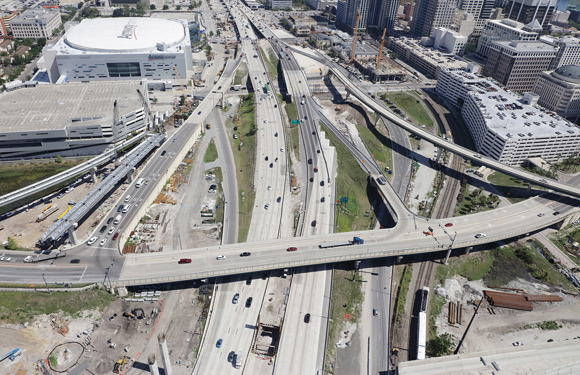
Motorists traveling on Interstate 4 (I-4) this Memorial Day weekend will not have to contend with I-4 Ultimate construction closures.
The Florida Department of Transportation (FDOT) is suspending lane and ramp closures between 11:30 p.m. on Friday, May 25, and 11 p.m. on Monday, May 28. The suspension of closures will help minimize potential traffic delays during the busy travel weekend.
Existing work zones will remain in effect. Crews will continue to maintain travel lanes and conduct routine maintenance. Maintenance work may require nighttime lane closures.
Motorists are reminded to use caution while traveling through the I-4 Ultimate work zone. FDOT encourages drivers to allow extra travel time and to use extra caution in existing work zones. Drivers are urged to make sure they buckle up, along with their passengers. FDOT also asks drivers to obey speed limits, get adequate rest before traveling, avoid distractions and never drink and drive.
|
|
Orlando Venues uses I-4 Ultimate Info to Ease Stress of Downtown Patrons
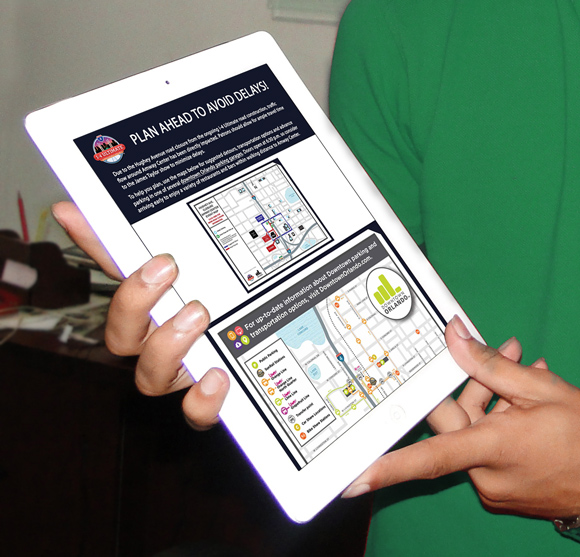
Orlando Venues – the City of Orlando department that manages five venues including Amway Center and Camping World Stadium – has found a way to help concertgoers and restaurant patrons enjoy downtown venues without stressing about traffic patterns on or around Interstate 4 (I-4).
The city takes the latest I-4 Ultimate info regarding lane closures and detours around the arena and stadium and sends it out to make sure those going to events are aware of any advisories. The messages also help market the greater downtown Orlando area with an invitation to “consider arriving early to enjoy a variety of restaurant and bars within walking distance to Amway Center.”
It’s all part of the City of Orlando’s effort to reassure those who attend events or want to try out a restaurant or pub that the ongoing I-4 Ultimate construction will not be too hard to navigate.
“We are committed to delivering the best possible customer service to our patrons, and transportation to and from the Amway Center is very much a part of the overall experience,” said Orlando Venues Chief Venues Officer Allen Johnson. “By proactively keeping patrons informed on what to expect when planning their visit, we're able to mitigate a lot of frustration and headaches. We want to make their night memorable for the right reasons.”
Orlando also typically sends advisory emails to ticketholders 48 hours prior to each concert at Amway Center and Camping World Stadium.
The e-cards, titled “What To Know Before You Go” and “Plan Ahead to Avoid Delays,” are sent to everyone attending a show who purchased tickets online via Ticketmaster.com.
Providing that information helps ensure a stress-free experience, said Kirk Wingerson, Marketing Division Manager for Orlando Venues. He noted that patrons who live, work or frequent downtown Orlando may know a great deal about the I-4 Ultimate project, but those coming from the suburbs or outlying markets like Tampa or Daytona often need some guidance.
The Orlando venues website also includes a bottom-of-the-page link to the I-4 Ultimate website, where viewers can find real-time traffic information on a specially designed, all-in-one, interactive construction map.
|
|
Smart Work Zone Helps Keep Motorists and Workers Safe
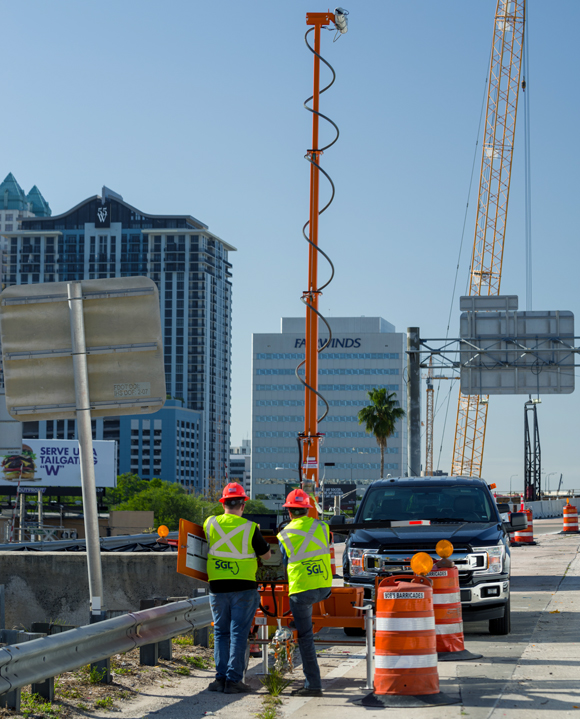
The I-4 Ultimate Maintenance of Traffic team has rolled out a solar-powered, mobile system that can sense traffic changes and automatically warn drivers of road conditions ahead.
In simple terms, the smart work zone system can detect traffic slowdowns and congestion on Interstate 4 (I-4). When it does, the system automatically sends a wireless signal back to an electronic sign, which then generates a preloaded message such as: “Caution work zone ahead.” Or “Caution slowed traffic ahead.”
The wireless signal can work over the distance of a couple of miles, depending on terrain; however, a half-mile is the optimal distance. The advance warning can prevent collisions with other vehicles and help protect those in construction zones nearby.
The smart work zone system, which can be easily moved to various spots along the 21-mile reconstruction project, is just one of the many ongoing safety initiatives of SGL – the joint construction venture of Skanska, Granite and Lane.
SGL had tested a similar automated system in 2016 and recently purchased a full system to help keep motorists safe and traffic moving. The system consists of four speed detectors, three electronic signs and two cameras.
When needed, the cameras allow approved members of the I-4 Ultimate team to monitor a situation remotely. The cameras do not record or store any images.
By using solar batteries and electronic signs with preloaded messages, the team also minimizes the number of times that workers need to go to a site beside the interstate to add a message or replace a power source. That, in turn, contributes to the overall safety and efficiency of the team.
|
|
I-4 Ultimate Team Preparing for
Hurricane Season
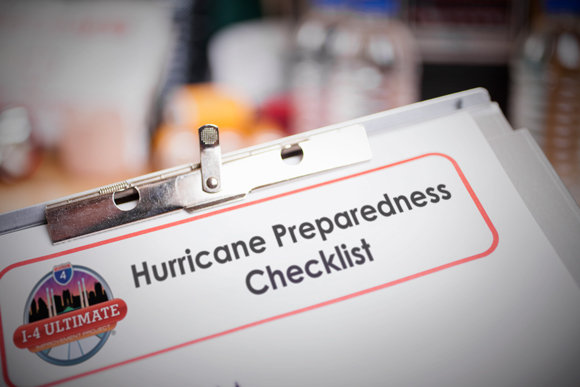
Hurricane season begins on June 1 and keeps Floridians on alert through the end of November. The I-4 Ultimate team remains vigilant, too, and ready to put its emergency preparation plans in place in case severe weather strikes Central Florida and the Interstate 4 (I-4) corridor.
The team follows state-approved policies to keep the public and employees safe, and to minimize damage to structures and equipment. Project managers also constantly review their plans to ensure essential personnel are safe and ready to respond.
When the Florida Department of Transportation gives the order, the I-4 Ultimate team follows its approved procedures to secure or remove traffic barrels, barricades, temporary signage and any other items that strong winds may carry off. Depending on weather conditions, workers also may lower the overhead lights on high-mast poles.
The I-4 Ultimate team ensures project personnel are safe and supplies are available. Some of the first preparations include stocking up on emergency supplies and making sure that equipment such as trucks, excavators, bulldozers and portable pumps and generators are fueled and working properly in case they need to be used in emergency situations.
After the storm subsides, the team inspects the site for damage, begins cleanup and drainage activities and then promptly gets back to its regular work schedule on the 21-mile project.
The Florida Department of Highway Safety and Motor Vehicles also has information and links for those who want to make sure their own severe weather plans are up-to-date.
|
|
The Tiny Building Blocks of the
I-4 Ultimate Project
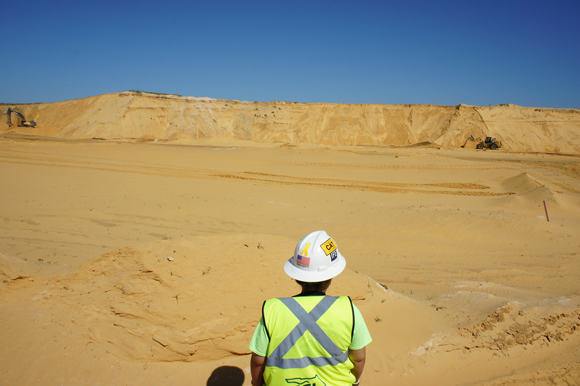
The bridges and ramps built by the I-4 Ultimate project draw their strength from tons of nearly indestructible concrete and steel, yet the stability of those immense structures often is founded upon tiny grains of sand.
Yes, the commonplace stuff you sweep off sidewalks is in some ways as essential to interstate construction as the power of concrete. But here’s the inside scoop: Not all sand qualifies for the job.
Some Central Florida sands are inextricably mixed with clay or other soils. Such blends often contain organic materials that can decompose over time, release chemicals that can corrode metallic support structures, cause the ground to shift, or just not drain well. In short, they are not good enough to function at the very bottom layer of heavy construction.
Currently, the I-4 Ultimate team draws that sand from a borrow pit in Clermont. In this case, the sand is called A-3 Select, and is hauled to various work sites to give steady strength to the foundations.
Tim Copple, who is Borrow Pit Manager for SGL – the construction joint partnership of Skanska, Granite and Lane – said that the project has taken 1.2 million cubic yards of sand from the Clermont mine. They expect to use 2.3 million cubic yards by the time the project ends in 2021.
That’s enough sand to fill about half of NASA’s 525-foot-tall Vehicle Assembly Building at Kennedy Space Center.
In Clermont, the I-4 Ultimate team is taking sand from an ongoing business that will continue to operate as a mine after the I-4 Ultimate team leaves. When the team completed its work at a sand pit near the Apopka Northwest Recreational Complex, it closed the operations and created a site that will store reclaimed water, support migratory birds and local wildlife, and complement the adjacent recreation area.
|
|
|










